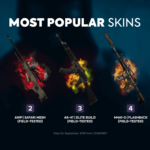What, besides luck, does the creator of skins need?
Artists whose skins are added to CS:GO can earn up to $100,000 a year or more! Excellent earnings, but to achieve it you need to get into the game. And that’s not so easy.
Besides of some luck, the skin creator must comply with a number of requirements and conditions from Valve. You also need a good idea and to implement it with the help of not so convenient tools. As well you will need performance, patience, community attention. And, of course, luck, its double amount obviously does not hurt with such strong competition.
Skins are added to the game as part of sets – “cases”. For example, the last case, CS20, contains almost two dozen skins that are dedicated to the twentieth anniversary of the game. Cases themselves are added to the game relatively rarely – once every few months. The main task of each creator of skins is to get into a small list of “skins” that will be in the next case.

In order for the skin to get into the game, according to the Valve FAQ, it must go through six stages:
Concept – come up with an idea;
Design – draw a draft;
Creation – turn a draft into a working one;
Completion – to bring the working version in line with the standards;
Acceptance – make a final skin check;
Publication – upload the work to the “Workshop”.
To create a skin, you will need to use a graphical editor such as Photoshop, and Workbench, a special tool for working with skins that is built into Counter-Strike: Global Offensive.
Valve gives recommendations when creating colors for weapons. CS:GO should be launched at a resolution of at least 1024×768, otherwise the Workbench interface may simply not fit. The skin texture itself should be in a .TGA file with a resolution of 24 bits. If the skin uses an alpha channel, then the bit depth should be 32 bits.
At the same time, the game does not know how to apply such files to weapon models. In order to see your own skin in the game, TGA needs to be compiled into a Valve Texture Format (VTF) file. After all this technological magic, you can see the skin and send it to Valve.
There are a number of limitations when creating skins. Skins containing offensive or indecent images, as well as images that violate copyrights, will be automatically rejected. In the history of the game, there were several stories of copyright infringement, which led to tightening of the rules. For example, the story of the legendary Howl.
Skins with gold, completely black or completely white color, as well as advertising colors will also go to the trash bin. National, religious and political symbols are also banned.
In addition, Valve does not recommend loading skins made in the styles of “Solid color” and “Anodizing”. The company says that they already have a huge supply of such skins, and new ones are unlikely to interest players. About what types of coloring skins exist in the game, you can read in our blog.
After the events related to M4A4 | Howl, Valve prefers to collaborate with trusted artists. This further complicates the life of new designers. Public opinion can help in obtaining recognition. Distribution of your skin, while still in the “Workshop”, can help attract the attention of the company. But even thousands of “pluses” on s1mple subreddit games and tweets do not guarantee Valve’s favor. The luck factor plays a role here, and you can only come to terms with this.
Creating a skin is a complex process from a technical, creative and marketing point of view. To successfully add a skin to the game, you need to go through a serious competition and be lucky enough to see your work from thousands of others. It is difficult, but not impossible.
So go for it!













